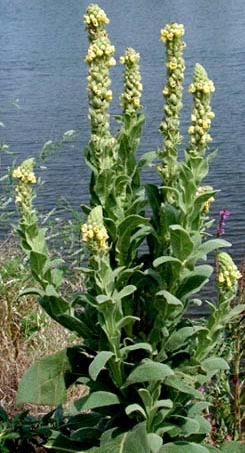By: Lisa C Bowers and Memi V. Heeder. 1995.
Abstract: Mullein is a primary successional species establishing a vegetative basis for later species. The purpose of this study was to determine whether mullein (Verbascum thapsus L.) is equally distributed in numbers between the eight islands in the Kachina Wetlands area. Three ponds were observed and the number of individual plants on each island within the three ponds were counted. The results were compared and the islands were found to be unequal in the distribution of the number of mullein plants.
Introduction: Throughout the Kachina Wetlands
 area, Verbascum thapsus is a common sight on islands in the ponds and on the berms delimiting the ponds. Mullein is a primary successional species in disturbed areas, and it establishes a vegetative basis which other species follow in later succession.
area, Verbascum thapsus is a common sight on islands in the ponds and on the berms delimiting the ponds. Mullein is a primary successional species in disturbed areas, and it establishes a vegetative basis which other species follow in later succession.The creation of the Kachina Wetlands area in 1988 left an ecologically disturbed substrate which mullein invaded and in which it thrived. Its seeds may lie dormant in the soil for up to forty years. Disturbance in the substrate can move seeds to a position in the soil where direct sunlight can stimulate germination and subsequent growth. Without direct sunlight, mullein can remain dormant in the soil for years (Reinartz, 1980).
V. thapsus is a biennial species establishing a rosette close to the ground during the first year and flowering or bolting the second year (Gross, 1981). As the inflorescence grows, the upper part of the stalk self-pollinates and flowers. Each flower singly lasts only one day before wilting. In late autumn, the leaves of the rosette die and the stalk releases its seeds to the surrounding area of roughly one meter (Reinartz, 1984). While little or no information is available on the distributive properties of mullein, it can be assumed that animals and birds may aid in the initial distribution of seeds to areas with low numbers of dormant seeds in the soil.
The eight ponds in the area were created at the same time, and at least one island was constructed in each of the ponds. Other things being equal, the populations of mullein should be the same size on each of the islands.
Methods: The number of plants on the islands in ponds 2, 4, and 8 were counted.
Results: There were two islands in Pond 2: the north island and the south island. The plants found on the north island of Pond 2, south island of Pond 2, Pond 4, and Pond 8 were 442, 573, 507, and 23, respectively.
Discussion: The numbers of mullein plants on the two islands in Pond 2 and the island in Pond 4 were similar, especially compared to the scarcity of plants found on the island in Pond 8.
 Verbascum has no methods for long-range dispersal, and with Pond 8 at the southwest corner of the wetland area and a prevailing southwest wind, mullein seeds may not have been as likely to reach that island as they were to reach ponds 2 and 4, which were in the center of the group of ponds. Pond 8 may not have been as likely to be the recipient of seeds dispersed by animals. There may have been fewer seeds in the soil used to build the island in Pond 8. The island in Pond 8 was smaller than the islands in the other two ponds.
Verbascum has no methods for long-range dispersal, and with Pond 8 at the southwest corner of the wetland area and a prevailing southwest wind, mullein seeds may not have been as likely to reach that island as they were to reach ponds 2 and 4, which were in the center of the group of ponds. Pond 8 may not have been as likely to be the recipient of seeds dispersed by animals. There may have been fewer seeds in the soil used to build the island in Pond 8. The island in Pond 8 was smaller than the islands in the other two ponds.Since the size of the islands differed, the habitable surface of the islands should have been measured and the density of the plants used for comparison. In addition, there should have been a statistical comparison of plant density. Not knowing the starting condition for number of seeds in the soil and their viability makes it impossible to rule out differences in island seed banks as a cause of the differences in populations. The drying effect of wind across the ponds at the Kachina Wetlands is a significant factor in plant survival there, so wind barriers and soil moisture may have been critical elements in mullein survival.
Literature Cited:
Gross, Katherine L. 1981. Predictions of fate from rosettes size in four "biennial" plant species: Verbascum thapsus, Oenothera biennis, Daucus carota, and Tragopogon dubuis. Oecologia 48:209-213.
Reinartz, James A. 1980. Latitudinal variation in the relationship between rosette diameter and fate in common mullein (Verbascum thapsus L.). The University of Wisconsin-Milwaukee Field Stations Bulletin 13(2):12-18.
Reinartz, James A. 1984. Life history variation of common mullein (Verbascum thapsus L.). Journal of Ecology 72:987-936.